
 You can eat the beautiful spring flowers as well as enjoy them in your garden, with this delicious cheesecake. Available from MackenzieLtd.com. You can eat the beautiful spring flowers as well as enjoy them in your garden, with this delicious cheesecake. Available from MackenzieLtd.com.

|
 |

May 2007 Gourmet News & Views
Trends, Products & Items Of Note In The World Of Specialty Foods
Gourmet News is published by 11 a.m. each Monday.
To send news releases, see below.
- Click here to return to the main Gourmet News page.
- You can receive the news via RSS by clicking on the RSS box above.
- You also can receive a weekly e-mail with links to this page by subscribing to the News Feed.
5.28.07
Product Watch
Nespresso Lattissimo. We recently visited the Nespresso concept store at 761 Madison Avenue in New York City, between 65th and 66th Streets.* What a pity that 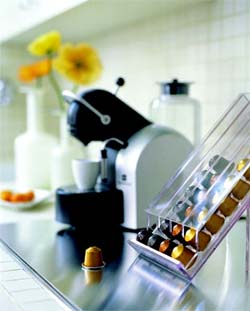 Nespresso doesn’t want to be in the coffee shop business, because this is as first-class an operation as one could wish for. If only we could wave a wand and have every other coffee shop we need to visit turn into a Nespresso shop. The many varieties of espresso (including cappuccino, latte and cold drinks) are perfetto, the furnishings are elegant, the staff is erudite, the prices are the same as at any other shop. But the purpose of the Nespresso Boutique Bar is to introduce Nespresso’s espresso machines. They are capsule machines: With just a touch of a button, perfect espresso is made in 10 seconds. There are nine premium espressos and three “lungo” blends (more American style for larger cups of coffee). In September, what we think is the world’s best cappuccino machine, the Lattissimo, will be on the market; so if you’re a cappuccino fan, put it on your list. It will be in the $650-$750 range, depending on finish. Learn more at Nespresso.com. Nespresso doesn’t want to be in the coffee shop business, because this is as first-class an operation as one could wish for. If only we could wave a wand and have every other coffee shop we need to visit turn into a Nespresso shop. The many varieties of espresso (including cappuccino, latte and cold drinks) are perfetto, the furnishings are elegant, the staff is erudite, the prices are the same as at any other shop. But the purpose of the Nespresso Boutique Bar is to introduce Nespresso’s espresso machines. They are capsule machines: With just a touch of a button, perfect espresso is made in 10 seconds. There are nine premium espressos and three “lungo” blends (more American style for larger cups of coffee). In September, what we think is the world’s best cappuccino machine, the Lattissimo, will be on the market; so if you’re a cappuccino fan, put it on your list. It will be in the $650-$750 range, depending on finish. Learn more at Nespresso.com.
*Open daily, weekdays 8 a.m. to 9 p.m., weekends 9 a.m. to 7 p.m.
Flavored Tequilas. If you need some diversion from the never-ending flavors of Absolut vodka, how about flavored tequila? New brand Tukys Tequila (pronounced too-keys, after the toucan mascot) is the only flavored tequila on the market, in multicolors just like the toucan. If you like sipping tequila, you can now do it in Kiwi-Strawberry, Lemon-Lime, Mandarin Orange, Vanilla Coffee and Watermelon. Now that Memorial Day has opened the doors to the Summer of Fun, plan a margarita party and let everyone vote on which flavor makes the best margarita. If you need to choose, Lemon-Lime does double duty as a good marinade for chicken, Mandarin Orange pairs with pork spare ribs. Learn more at Tukys.com.
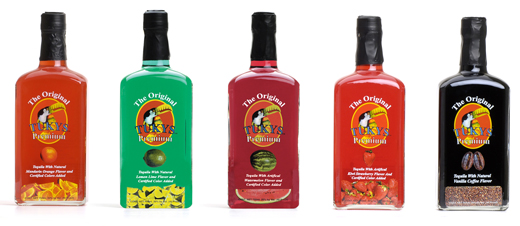
Cooler Champagne. Piper-Heidsieck has been around since since 1785: It was a 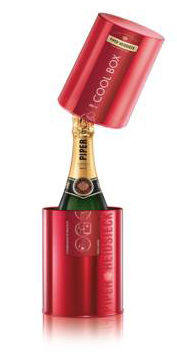 favorite of Marie Antoinette, and Marilyn Monroe is said to have awoken every morning to a glass of Piper (she may have preferred coffee, but Champagne made better fodder for magazines). This summer, the venerable Champagne house is making an effort to be cool while keeping its patrons cool. One approach is the Piper-Heidsieck Cool Box, a bottle of Piper Cuvée Brut that comes in its own handsome Champagne chilling container. Another is by promoting the Piscine (French for “swimming pool”) cocktail served with Champagne ice cubes instead of in a flute. After you pour it from the Cool Box, your glass of bubbly stays ice cold while you laze in the sun. Of course, you need to devote part of a bottle of Champagne to making the ice cubes, so it helps to have a Champagne re-corker to save the rest until the ice cubes are firm. Since ice cubes won’t fit in a Champagne flute, Piper-Heidsieck is offering an oversized, red goblet in Piper Brut’s signature red (although any wine goblet will do). If Dad likes Champagne, this is a nice riff on the usual bottle. favorite of Marie Antoinette, and Marilyn Monroe is said to have awoken every morning to a glass of Piper (she may have preferred coffee, but Champagne made better fodder for magazines). This summer, the venerable Champagne house is making an effort to be cool while keeping its patrons cool. One approach is the Piper-Heidsieck Cool Box, a bottle of Piper Cuvée Brut that comes in its own handsome Champagne chilling container. Another is by promoting the Piscine (French for “swimming pool”) cocktail served with Champagne ice cubes instead of in a flute. After you pour it from the Cool Box, your glass of bubbly stays ice cold while you laze in the sun. Of course, you need to devote part of a bottle of Champagne to making the ice cubes, so it helps to have a Champagne re-corker to save the rest until the ice cubes are firm. Since ice cubes won’t fit in a Champagne flute, Piper-Heidsieck is offering an oversized, red goblet in Piper Brut’s signature red (although any wine goblet will do). If Dad likes Champagne, this is a nice riff on the usual bottle.
Hemp & Chocolate. It almost sounds like Haight-Ashbury in the ‘60s, but everything old is new again—and this hemp is legal. New Hemp Seed Chocolate Bar 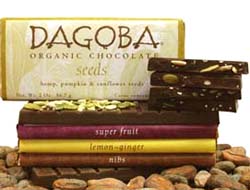 Organic chocolate pioneer Dagoba has introduced a 68% cacao chocolate bar—still semisweet (the bittersweet border is considered to be 70%), with omega-rich hemp seeds, heart-healthy pumpkin and sunflower seeds and to remind us that it’s a modern bar, a touch of Balinese sea salt. Don’t be convinced that this is health food though: There’s enough fat and sugar in any chocolate bar to make “health benefits” a delusion (the exception to the rule is that those who eat 99% or 100% cacao avoid the sugar—but that’s not most of us). For more information, visit DagobaChocolate.com. Organic chocolate pioneer Dagoba has introduced a 68% cacao chocolate bar—still semisweet (the bittersweet border is considered to be 70%), with omega-rich hemp seeds, heart-healthy pumpkin and sunflower seeds and to remind us that it’s a modern bar, a touch of Balinese sea salt. Don’t be convinced that this is health food though: There’s enough fat and sugar in any chocolate bar to make “health benefits” a delusion (the exception to the rule is that those who eat 99% or 100% cacao avoid the sugar—but that’s not most of us). For more information, visit DagobaChocolate.com.
Gourmet Travel
Classes At CIA-Napa. The Culinary Institute of America (CIA), the world’s premier culinary college, has unveiled a new type of culinary vacation for food and wine and travel enthusiasts at its Greystone campus in Napa Valley. The CIA Sophisticated Palate offers five epicurean adventures, exploring the flavors of Spain and Portugal, Southeast Asia, Northern California and other adventures. The two- and four-day programs allow travelers to spend more of their vacation time exploring Napa Valley and nearby Sonoma and Mendocino plus San Francisco. For more information about the CIA Sophisticated Palate program, visit ciachef.edu.
5.21.07
News
Spinach Is Back & Strong. After last fall’s E. coli food-borne illness scare, spinach sales plunged. But Popeye’s favorite is back, thanks in part to its low calories and dense nutrition, and in part to restaurant chefs who enjoy working with the versatile vegetable—in salads, as a bed for entrees, as an ingredient in gnocchi and other pasta 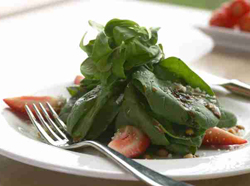 dishes. Nation’s Restaurant News reported on some popular new dishes at restaurants nationwide that you can make at home: a steak and Gorgonzola salad with arugula and spinach, tossed with vinaigrette and garnished with candied walnuts (from Maggiano’s Little Italy in Dallas). We love nutmeg as a seasoning for spinach, but Youssef Hammi, chef at Himmarshee Bar & Grille in Fort Lauderdale, recommends sage. To get more vegetables in your diet, serve grilled fish, chicken or other protein atop a bed of wilted baby spinach leaves; add some toasted pine nuts and a dab of garlic butter or other compound butter. Spinach is high in vitamins A, C, K and folate and is also a good source of iron and magnesium. It also features lutein, an antioxidant that protects against macular degeneration, or loss of eyesight. If you still feel anxiety about bringing spinach back, remember that it was regular spinach that caused the problems last year, not baby spinach. dishes. Nation’s Restaurant News reported on some popular new dishes at restaurants nationwide that you can make at home: a steak and Gorgonzola salad with arugula and spinach, tossed with vinaigrette and garnished with candied walnuts (from Maggiano’s Little Italy in Dallas). We love nutmeg as a seasoning for spinach, but Youssef Hammi, chef at Himmarshee Bar & Grille in Fort Lauderdale, recommends sage. To get more vegetables in your diet, serve grilled fish, chicken or other protein atop a bed of wilted baby spinach leaves; add some toasted pine nuts and a dab of garlic butter or other compound butter. Spinach is high in vitamins A, C, K and folate and is also a good source of iron and magnesium. It also features lutein, an antioxidant that protects against macular degeneration, or loss of eyesight. If you still feel anxiety about bringing spinach back, remember that it was regular spinach that caused the problems last year, not baby spinach.
Beyond Mere “Coffee and Cake.” It’s no longer as simple as deciding whether you want the Costa Rican brew or an espresso when you order coffee because you like 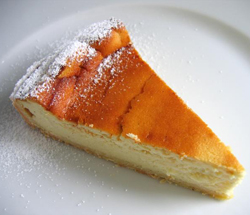 the way those coffees taste. Now, you’re going to learn which coffee pairs best with which food. The foodservice division of Sara Lee, the country’s largest dining program coffee producer whose offerings include Douwe Egberts (the coffee in Senseo pods) and Superior Coffee, has developed a tool to help restaurants figure out what coffee to suggest to customers who order particular foods. Cheesecake, with its high fat content, calls for a dark roast, heavy bodied coffee with a high acidity level, while a fudge brownie should be paired with a coffee that has a lower acidity level. Pound cake goes better with a light roast coffee with high acidity. While many foodies will welcome learning the science of pairing coffee, we imagine others will continue to enjoy espresso with that pound cake. Photo by Rose Vita | Morguefile. the way those coffees taste. Now, you’re going to learn which coffee pairs best with which food. The foodservice division of Sara Lee, the country’s largest dining program coffee producer whose offerings include Douwe Egberts (the coffee in Senseo pods) and Superior Coffee, has developed a tool to help restaurants figure out what coffee to suggest to customers who order particular foods. Cheesecake, with its high fat content, calls for a dark roast, heavy bodied coffee with a high acidity level, while a fudge brownie should be paired with a coffee that has a lower acidity level. Pound cake goes better with a light roast coffee with high acidity. While many foodies will welcome learning the science of pairing coffee, we imagine others will continue to enjoy espresso with that pound cake. Photo by Rose Vita | Morguefile.
Product Watch
Not Just Peanuts. Organic Wild Amazonian Jungle Peanuts, from the rainforest of Ecuador, are raw nuts from a strain of ancient peanuts. They have dramatic good looks: Their golden-brown skin with wide burgundy stripes makes a handsome garnish. 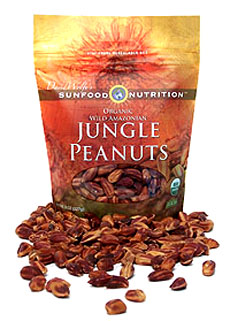 The nut underneath is a creamy white color, like the macadamia. Raw and unsalted, their taste is subtle compared to the common goobers we’re used to, somewhat green and healthy-tasting with interesting nuances and a softer texture than most nuts. Most people might not guess they’re peanuts. Like any other peanut, they can be eaten straight out of the bag or added to recipes, and score high in nutrition: 26% protein, heart-healthy oleic acid, all eight essential amino acids and arachidonic acid, a fatty acid typically only found in meat products. For more information about Organic Wild Amazonian Jungle Peanuts, visit Sunfood.com. Sunfood Nutrition founder David Wolfe is also the President of The Fruit Tree Planting Foundation (ftpf.org), a nonprofit organization dedicated to planting fruitful trees and edible plants to benefit the environment and its inhabitants. FTPF’s mission is to plant 18 billion fruit trees across the world and encourage their growth under organic standards. The nut underneath is a creamy white color, like the macadamia. Raw and unsalted, their taste is subtle compared to the common goobers we’re used to, somewhat green and healthy-tasting with interesting nuances and a softer texture than most nuts. Most people might not guess they’re peanuts. Like any other peanut, they can be eaten straight out of the bag or added to recipes, and score high in nutrition: 26% protein, heart-healthy oleic acid, all eight essential amino acids and arachidonic acid, a fatty acid typically only found in meat products. For more information about Organic Wild Amazonian Jungle Peanuts, visit Sunfood.com. Sunfood Nutrition founder David Wolfe is also the President of The Fruit Tree Planting Foundation (ftpf.org), a nonprofit organization dedicated to planting fruitful trees and edible plants to benefit the environment and its inhabitants. FTPF’s mission is to plant 18 billion fruit trees across the world and encourage their growth under organic standards.
Organic Peanut Butter Bonbons. If you prefer your peanuts as peanut butter—with chocolate—you might want to know about Vosges Haut Chocolat’s first 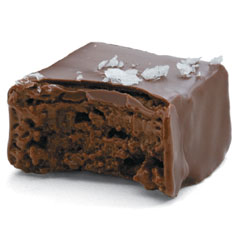 foray into organics, with an Organic Peanut Butter Bon. A creamy peanut butter center is covered in deep milk chocolate and topped with Fleur de Sel from France, plus Pink Himalayan Salt, mined from deep inside the Himalayan Mountains where it was deposited from the sea over 250 million years ago (often the salt is brought down from the mountains on the backs of yaks). For more information, visit VosgesChocolate.com. For peanut trivia: About one-third of peanuts grown in the U.S. are used to make peanut butter; two-thirds of all U.S. peanuts are grown in Georgia, Alabama and Florida. foray into organics, with an Organic Peanut Butter Bon. A creamy peanut butter center is covered in deep milk chocolate and topped with Fleur de Sel from France, plus Pink Himalayan Salt, mined from deep inside the Himalayan Mountains where it was deposited from the sea over 250 million years ago (often the salt is brought down from the mountains on the backs of yaks). For more information, visit VosgesChocolate.com. For peanut trivia: About one-third of peanuts grown in the U.S. are used to make peanut butter; two-thirds of all U.S. peanuts are grown in Georgia, Alabama and Florida.
Gourmet Travel
Cook With Andre Soltner. Foodies who never had the opportunity to dine at the legendary New York restaurant Lutèce—or who did and want more of Andre Soltner’s 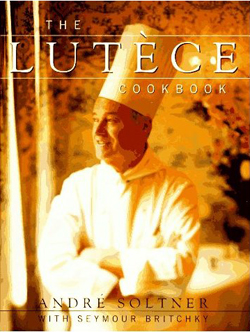 food—have an opportunity next month. (The restaurant closed under new management several years after Chef Soltner retired in 1995.) From June 25th to June 29th, Soltner will be guest chef at Curtain Bluff resort in Antigua. In addition to cooking for guests, he will hold cooking demonstrations and classes with Curtain Bluff’s Chef Christophe Blatz. Classes are complimentary to any guest booking an Executive Suite or higher category room. Special Summer Rates are $595 per day (double occupancy), which includes all meals, activities and cooking classes. For more information call 1.888.289.9898 or visit CurtainBluff.com. If you can’t make the trip, you can buy The Lutèce Cookbook, written by Soltner and Seymour Britchky, The New York Times restaurant critic during many of Lutece’s golden years. food—have an opportunity next month. (The restaurant closed under new management several years after Chef Soltner retired in 1995.) From June 25th to June 29th, Soltner will be guest chef at Curtain Bluff resort in Antigua. In addition to cooking for guests, he will hold cooking demonstrations and classes with Curtain Bluff’s Chef Christophe Blatz. Classes are complimentary to any guest booking an Executive Suite or higher category room. Special Summer Rates are $595 per day (double occupancy), which includes all meals, activities and cooking classes. For more information call 1.888.289.9898 or visit CurtainBluff.com. If you can’t make the trip, you can buy The Lutèce Cookbook, written by Soltner and Seymour Britchky, The New York Times restaurant critic during many of Lutece’s golden years.
5.14.07
News
Coffee: Health Food. Long regarded by many as a “necessary evil,” new scientific research may soon help coffee shed some of its unhealthy image and make the many millions of American coffee drinkers feel good about their brew. Recent research showed coffee to have a decent level of antioxidants. Now, reports WebMD Medical 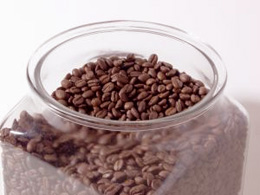 News, a growing body of research suggests that heavy coffee consumption may lower the risk of Type 2 diabetes and other serious diseases. Rob M. van Dam, PhD, a Harvard researcher, concludes from an analysis he did in 2005 of eight major studies that adults who consume six to seven cups of coffee per day lower their risk of diabetes by one-third over those who drink two cups per day. He stated that another study done last year showed that two or three cups per day lowered women’s diabetes risk by 13%, four or more cups per day cut the risk by more than 40%. At least seven other studies suggest similar benefits. According to Lenore Arab, PhD, a nutritional epidemiologist at UCLA, other studies suggest that coffee could help lower the risk of liver cancer, Parkinson’s disease, and possibly colon cancer. This is good news to the tens of millions of American coffee drinkers. News, a growing body of research suggests that heavy coffee consumption may lower the risk of Type 2 diabetes and other serious diseases. Rob M. van Dam, PhD, a Harvard researcher, concludes from an analysis he did in 2005 of eight major studies that adults who consume six to seven cups of coffee per day lower their risk of diabetes by one-third over those who drink two cups per day. He stated that another study done last year showed that two or three cups per day lowered women’s diabetes risk by 13%, four or more cups per day cut the risk by more than 40%. At least seven other studies suggest similar benefits. According to Lenore Arab, PhD, a nutritional epidemiologist at UCLA, other studies suggest that coffee could help lower the risk of liver cancer, Parkinson’s disease, and possibly colon cancer. This is good news to the tens of millions of American coffee drinkers.
Kinder, Gentler Foie Gras. A Hungarian goose farmer recently invented a soft rubber tube to replace the metal tube that has been used for millennia to fatten goose livers (the process was invented by the ancient Egyptians). Earlier, a Hungarian poultry scientist, Dr. Ferenc Bogenfürst, successfully shortened the time geese were force fed, to 14 or 15 days from 18 to 21 days, and reduced the number of force feedings per day. A California foie gras producer, Tom Brock, finds the entire process gentler on his animals. While it may, in fact, improve the process, there is little likelihood it will improve the feelings of the animal rights activists who are hell-bent on  eliminating the rights of Americans to eat foie gras. They achieved a huge victory by getting Arnold Schwartzenegger to support a law that will ban foie gras starting in 2012 (we’re betting the Governator personally doesn’t like foie gras) and the Chicago Assembly to outlaw the sale of foie gras last year. The same activists are attempting to instigate action in New York and elsewhere; while we don’t anticipate foie gras speakeasies, Chicago restaurants have shown creative ways of getting around the legislation. Opponents of foie gras say the procedure of using feeding tubes is painful and sickens the birds, but no veterinary organizations have supported this stance. Supporters say the birds’ gullets are naturally expandable (think of pelicans swallowing whole fish), and that they naturally gorge before migrating, so that neither of the alleged “cruel and unusual punishment” accusations are valid. THE NIBBLE fears the danger of allowing fringe groups to legislate what can be eaten, worn or otherwise consumed—has always been surprised that, given the tiny size of the foie gras industry, animal activists are so vehement about spending their time and energy on such a small group of animals that is farmed in just a handful of countries. We opine that their concerns for animal welfare could make a truly significant impact by improving the condition of the many millions of lobsters and crabs, who are plunged live to their deaths in boiling water in many nations around the world. Between finding a less painful way to kill many millions of crustaceans and the feeding method of thousands of geese, which problem should be solved first? eliminating the rights of Americans to eat foie gras. They achieved a huge victory by getting Arnold Schwartzenegger to support a law that will ban foie gras starting in 2012 (we’re betting the Governator personally doesn’t like foie gras) and the Chicago Assembly to outlaw the sale of foie gras last year. The same activists are attempting to instigate action in New York and elsewhere; while we don’t anticipate foie gras speakeasies, Chicago restaurants have shown creative ways of getting around the legislation. Opponents of foie gras say the procedure of using feeding tubes is painful and sickens the birds, but no veterinary organizations have supported this stance. Supporters say the birds’ gullets are naturally expandable (think of pelicans swallowing whole fish), and that they naturally gorge before migrating, so that neither of the alleged “cruel and unusual punishment” accusations are valid. THE NIBBLE fears the danger of allowing fringe groups to legislate what can be eaten, worn or otherwise consumed—has always been surprised that, given the tiny size of the foie gras industry, animal activists are so vehement about spending their time and energy on such a small group of animals that is farmed in just a handful of countries. We opine that their concerns for animal welfare could make a truly significant impact by improving the condition of the many millions of lobsters and crabs, who are plunged live to their deaths in boiling water in many nations around the world. Between finding a less painful way to kill many millions of crustaceans and the feeding method of thousands of geese, which problem should be solved first?
Photo of goose courtesy of StockXchng.
Chocolate Show Celebrates 10th Anniversary In NYC; New Chocolate Show In San Francisco. The International Chocolate Show, held each year in New York, Paris, Tokyo, Beijing,  and Moscow, has announced that the 10 year anniversary of the show will be held at the New York show, from November 9th to 11th. The show is held at the Metropolitan Pavilion and Altman Building in New York City. This year’s show will feature some of the most famous pastry chefs and chocolate makers in the U.S., beginning with the chocolate fashion show—leading fashion designers paired with pastry chefs creating unconventional clothing in chocolate—on the evening of Thursday, November 8. For the 10th anniversary celebration, the week leading up to the main chocolate fashion show will be filled with an extensive program of mini events. Mark your calendars! Read more about the International Chocolate Show. In San Francisco, a different producer is launching the San Francisco Chocolate Salon, debuting July 14 and 15 at Fort Mason Conference Center. For information visit SFChocolateSalon.com. and Moscow, has announced that the 10 year anniversary of the show will be held at the New York show, from November 9th to 11th. The show is held at the Metropolitan Pavilion and Altman Building in New York City. This year’s show will feature some of the most famous pastry chefs and chocolate makers in the U.S., beginning with the chocolate fashion show—leading fashion designers paired with pastry chefs creating unconventional clothing in chocolate—on the evening of Thursday, November 8. For the 10th anniversary celebration, the week leading up to the main chocolate fashion show will be filled with an extensive program of mini events. Mark your calendars! Read more about the International Chocolate Show. In San Francisco, a different producer is launching the San Francisco Chocolate Salon, debuting July 14 and 15 at Fort Mason Conference Center. For information visit SFChocolateSalon.com.
Product Watch
Hershey’s Antioxidant Milk Chocolate. You may have seen the recent adds for Hershey’s natural Flavanol Antioxidant Milk Chocolate, with “more flavanol 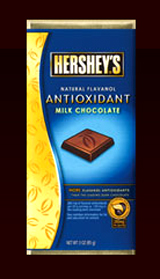 antioxidants than the leading dark chocolate.” That may be, but don’t expect antioxidant health benefits from eating it given the 19 grams of sugar, 180 calories and 100 fat calories in a 1.3-ounce bar. It’s a bar of extremely sweet milk chocolate—not unlike a regular Hershey bar, the sugar overwhelms the chocolate flavor. While the company promotes “smooth, creamy milk chocolate taste,” we find that it has the texture of inexpensive chocolate—fibrous, not melt-in-your-mouth creamy in the least. Our recommendation: Forget the antioxidant hype, there aren’t enough antioxidants in this bar to do anything but make you feel psychologically better. If you want to eat a wonderful milk chocolate bar, try the company’s fine Cacao Reserve by Hershey’s line, which features an excellent 35% cacao blended* milk chocolate bar and a 32% cacao bar with beans from Java, or the 41% blended bar from Hershey-owned Scharffen Berger Chocolate Maker, and get your antioxidants from a good cup of (calorie free) tea or yerba mate. But don’t put milk in it—recent research has proven that the casein (protein) in milk interacts with tea, decreasing the concentration of catechin, the flavonoids in tea that protect against heart disease. The beneficial effects of drinking black tea are completely prevented by the addition of milk. That’s why green tea, which tastes so good without milk or sugar is the better bet. antioxidants than the leading dark chocolate.” That may be, but don’t expect antioxidant health benefits from eating it given the 19 grams of sugar, 180 calories and 100 fat calories in a 1.3-ounce bar. It’s a bar of extremely sweet milk chocolate—not unlike a regular Hershey bar, the sugar overwhelms the chocolate flavor. While the company promotes “smooth, creamy milk chocolate taste,” we find that it has the texture of inexpensive chocolate—fibrous, not melt-in-your-mouth creamy in the least. Our recommendation: Forget the antioxidant hype, there aren’t enough antioxidants in this bar to do anything but make you feel psychologically better. If you want to eat a wonderful milk chocolate bar, try the company’s fine Cacao Reserve by Hershey’s line, which features an excellent 35% cacao blended* milk chocolate bar and a 32% cacao bar with beans from Java, or the 41% blended bar from Hershey-owned Scharffen Berger Chocolate Maker, and get your antioxidants from a good cup of (calorie free) tea or yerba mate. But don’t put milk in it—recent research has proven that the casein (protein) in milk interacts with tea, decreasing the concentration of catechin, the flavonoids in tea that protect against heart disease. The beneficial effects of drinking black tea are completely prevented by the addition of milk. That’s why green tea, which tastes so good without milk or sugar is the better bet.
*The beans are a blended from a variety of regions around the world, as opposed to the single origin Java bar.
Great Salted Chocolate. Salted chocolate is one of the greatest flavor 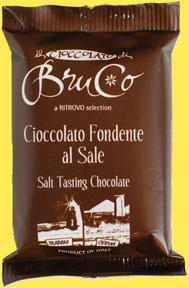 combinations to hit town over the last several years. We admit a fondness for all salted bars, including Vosges’ Barcelona Bar, 40% milk chocolate, hickory-smoked almonds and grey sea salt. The low-tech version is to sprinkle some sea salt on your favorite chocolate bar, but serious chocolate lovers will want to order some Cioccolato di BruCo, a very fine artisan chocolate from Italy. The company has created a salt-and-chocolate-taster’s mini kit combining its 72% bittersweet chocolate with two highly-regarded, organoleptically different sea salts, from Cervia in Emilia Romagna and Trapani off of Sicily’s Northwestern Coast. The contrast between the two different chocolate/salt profiles provides a mini salt chocolate tasting course: the Trapani salt is intense and spicy, the Cervia salt is mild with hints of Champagne. The product is imported by Ritrovo Italian Regional Foods and is available at TheMeadowFlowers.com. combinations to hit town over the last several years. We admit a fondness for all salted bars, including Vosges’ Barcelona Bar, 40% milk chocolate, hickory-smoked almonds and grey sea salt. The low-tech version is to sprinkle some sea salt on your favorite chocolate bar, but serious chocolate lovers will want to order some Cioccolato di BruCo, a very fine artisan chocolate from Italy. The company has created a salt-and-chocolate-taster’s mini kit combining its 72% bittersweet chocolate with two highly-regarded, organoleptically different sea salts, from Cervia in Emilia Romagna and Trapani off of Sicily’s Northwestern Coast. The contrast between the two different chocolate/salt profiles provides a mini salt chocolate tasting course: the Trapani salt is intense and spicy, the Cervia salt is mild with hints of Champagne. The product is imported by Ritrovo Italian Regional Foods and is available at TheMeadowFlowers.com.
Stonyfield Farm Introduces Organic Greek Yogurt. Stonyfield, the country’s largest maker of organic yogurt, has partnered with Euphrates Inc. to create an new 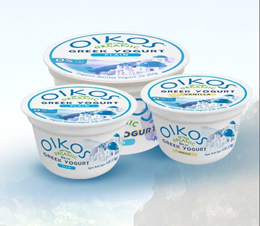 certified-organic, authentically strained Greek-style yogurt, which is thicker than European-style yogurt, called Oikos Organic (oikos means house or household in Greek). Using authentic Greek recipes, the yogurt is made in the U.S.The brand will be called Greek-style yogurts are the fastest growing segment in natural foods channels. The Oikos line has 0% fat and is available in both plain and vanilla, the latter a new flavor for lovers of Greek yogurt. The yogurt includes five live and active cultures, including L. acidophilus, Bifidus and L. Casei. It’s diet-friendly, with 120 calories or less, 0g fat and 16g of protein per 6-ounce serving. The suggested retail price is $1.89 per 6-ounce cup and $4.49 per 16-ounce tub. Learn more at OikosYogurt.com. certified-organic, authentically strained Greek-style yogurt, which is thicker than European-style yogurt, called Oikos Organic (oikos means house or household in Greek). Using authentic Greek recipes, the yogurt is made in the U.S.The brand will be called Greek-style yogurts are the fastest growing segment in natural foods channels. The Oikos line has 0% fat and is available in both plain and vanilla, the latter a new flavor for lovers of Greek yogurt. The yogurt includes five live and active cultures, including L. acidophilus, Bifidus and L. Casei. It’s diet-friendly, with 120 calories or less, 0g fat and 16g of protein per 6-ounce serving. The suggested retail price is $1.89 per 6-ounce cup and $4.49 per 16-ounce tub. Learn more at OikosYogurt.com.
Trends
Sustainable Seafood. Which fish can you eat with a clean conscience? At a time when scientists are warning that commercial fish stocks could collapse altogether by 2048, you can shop for fish—and order restaurant meals—that do not deplete the world’s oceans. Chefs, too, are becoming more and more concerned. “For all of human history, we’ve seen the ocean as an endless, vast resource,” Barton Seaver, chef-owner of the Georgetown seafood restaurant, Hook, told the Washington Post. Seaver has joined a growing number of chefs in Washington and elsewhere who, motivated by a mix of ethical and pragmatic concerns, are trying to serve only fish that can reproduce at the rate they’re being caught. Our appetite for fish continues to rise as our nation’s—and the world’s—fish stocks are imperiled. According to the National Oceanic and Atmospheric Administration Fisheries Service, between 2001 and 2005, per-capita annual U.S. seafood consumption rose from 14.8 pounds to 16.2 pounds; more than half of which was eaten in restaurants. But according to an analysis by Rebecca Goldberg, a scientist with the advocacy group Environmental Defense, roughly one in three U.S.-managed fisheries is already overfished or getting there. Trying to make fish “sustainable” is a challenge, because consumers want the popular fish, which, therefore, continue to get overfished. The overfished Chilean seabass, for example, for the less familiar Alaskan sablefish. Instead of swordfish, try Hawaiian wahoo. You can have an impact: Between 1998 and 2000, the conservation groups SeaWeb and Natural Resources Defense Council ran a campaign called “Give Swordfish a Break,” persuading more than 700 U.S. chefs and three major cruise lines to stop serving North Atlantic swordfish. The fish recovered from 65% of sustainable levels in 1998 to 94% in 2002. You can consult the Monterey Bay Aquarium’s Seafood Watch list to find out which stocks are depleted from overfishing or contaminated by pollution. You can print out a wallet-size guide while you’re there. The results are eye-opening: Many of our favorite fish are on the depleted list. But, it’s easy to make a change. Read more about Seafood Watch.

Please don’t eat the Chilean Seabass: It’s seriously overfished! Photo courtesy of Wikipedia.

5.7.07
News
Holy Cow: 2006 Dairy Industry Stats Reported. The U.S. Department of Agriculture released a summary of Dairy Products Industry for 2006. Total cheese production, excluding cottage cheeses, was 9.53 billion pounds, 4.2 percent above 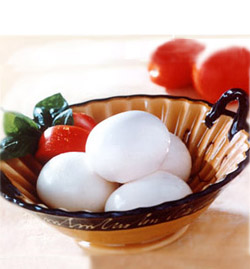 2005 production. Wisconsin was the leading state producer, with 25.9% of the production; California took second. Not surprisingly, due to the popularity of pizza and other Italian foods, Italian varieties led production, with 3.99 billion pounds accounting for 41.8% of total cheese produced in 2006. Mozzarella accounted for 78.8% of the Italian production, followed by Provolone with 8% and Ricotta with 6.1%. California was the leading state in Italian cheese production, manufacturing 29.7%. Following America’s love of cheeseburgers, American-type cheese was the second largest type produced, at 3.91 billion pounds; Wisconsin led with 21% of production. We consumed 2005 production. Wisconsin was the leading state producer, with 25.9% of the production; California took second. Not surprisingly, due to the popularity of pizza and other Italian foods, Italian varieties led production, with 3.99 billion pounds accounting for 41.8% of total cheese produced in 2006. Mozzarella accounted for 78.8% of the Italian production, followed by Provolone with 8% and Ricotta with 6.1%. California was the leading state in Italian cheese production, manufacturing 29.7%. Following America’s love of cheeseburgers, American-type cheese was the second largest type produced, at 3.91 billion pounds; Wisconsin led with 21% of production. We consumed
1.45 billion pounds, 31% made in California, 26.2% in Wisconsin. While cheese and butter experienced growth from 3.5% to 7.5% (for butter), America is cutting back on its ice cream. Regular ice cream sales—966 million gallons worth—was up only 0.6 percent, frozen yogurt up just 2% (67.5 million gallons), and sherbet, the healthiest option, was down 7.6% (52.1 million gallons). Lowfat ice cream, however, was up 3.3% (372 million gallons). Photo of Mozzarella, America’s best-selling cheese, courtesy of Mozzarella Company.
Product Watch
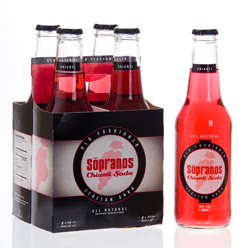 Drink With The Sopranos. “The Sopranos” TV series finale is next month, but you can watch the reruns on A&E for years as you drink The Sopranos™ Old Fashioned Italian Sodas. Licensed by HBO®, the three initial flavors: Amaretto, Chianti and Limoncello. The European-style sodas, which do not contain alcohol despite the names, are made of all-natural ingredients, including sugar instead of high fructose corn syrup. The sodas are now shipping to grocery stores, supermarkets and convenience stores as well as select sandwich shops and restaurants across the country. Drink With The Sopranos. “The Sopranos” TV series finale is next month, but you can watch the reruns on A&E for years as you drink The Sopranos™ Old Fashioned Italian Sodas. Licensed by HBO®, the three initial flavors: Amaretto, Chianti and Limoncello. The European-style sodas, which do not contain alcohol despite the names, are made of all-natural ingredients, including sugar instead of high fructose corn syrup. The sodas are now shipping to grocery stores, supermarkets and convenience stores as well as select sandwich shops and restaurants across the country.
Kagome Expands Juice Line. Tokyo juice company Kagome is bringing its fruit and vegetable blends to the U.S.: seven flavors, including Autumn Reds, Burgundy Berry Blossom, Golden Peach Garden, Orange Carrot Blossom, Purple Roots and Fruits, Ruby Pomegranate Harmony and Yellow Mango Orchard. Kagome, whose lime-accented Sweet Summer Tomato Juice showed well in our “Best Tomato Juice” review, will be sold at Whole Foods Markets, among other stores, competing against other higher-end brands like R.W. Knudsen.
| Kagome juices in 30-ounce bottles and 11.5-ounce single-serves. |
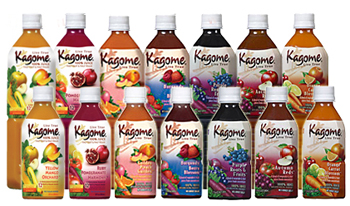 |
Trends
Saké Soars. While everyone knows the name, few people really understand the drink. But that may change, since while the market for saké remains relatively small, it is growing in leaps and bounds. Books on the topic proliferate: Perhaps a bottle of fine saké (not the kind you buy hot by the carafe at a sushi bar) and a book on the topic would be a good gift for Mother’s Day or Father’s Day? Some quick pointers:
- It’s pronounced “SAH-keh,” not “SAH-kee.”
- While it’s made from rice and often referred to as “rice wine,” it’s not technically a wine, which, by definition is fermented from fruit. Like beer, saké is fermented from grain, although the the production process is significantly different.
- Saké is categorized according to the percentage of the outer husk of the rice that is milled away, or polished, before processing. This enables more complex flavors to develop. While the categorizations do not necessarily reflect the quality of the saké, in general, the more of the grain that is eliminated, the more delicate the flavor of the saké tends to be.
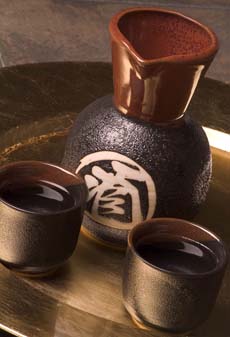 A saké with at least 30% of the grain removed is referred to as junmai or junmaishu; at least 40% is ginjo or ginjoshu. Junmais and ginjos can be paired with bigger flavor foods, like toro, grilled chicken and tempura. Rice polished 50% or more creates the more delicate daiginjo or daiginjoshu sakés, which pairs with more gently flavored foods, such as poached whitefish or raw scallop. A fourth category, honjozo or honjozukuri, refers to a saké to which a small amount of pure alcohol has been added during the fermentation period. And a fifth type, nigori or nigorizaké is loosely filtered saké that is cloudy, almost milky white. Pair them with spicy or heavily fried foods and lighter meats. A saké with at least 30% of the grain removed is referred to as junmai or junmaishu; at least 40% is ginjo or ginjoshu. Junmais and ginjos can be paired with bigger flavor foods, like toro, grilled chicken and tempura. Rice polished 50% or more creates the more delicate daiginjo or daiginjoshu sakés, which pairs with more gently flavored foods, such as poached whitefish or raw scallop. A fourth category, honjozo or honjozukuri, refers to a saké to which a small amount of pure alcohol has been added during the fermentation period. And a fifth type, nigori or nigorizaké is loosely filtered saké that is cloudy, almost milky white. Pair them with spicy or heavily fried foods and lighter meats.- About three-quarters of all the saké produced in Japan is futsushu, ordinary saké, milled down to only 70%. It is generally served warm, while premium saké is generally served slightly chilled, like white wine.
Learn more about saké.
Vinify Your Own. Saké isn’t the only emerging trend in alcoholic beverages. Home brewing and winemaking as a hobby is growing at a rapid pace. The do-it-yourself beer and wine industry is approaching $100 million in annual sales as more people take up the hobby, estimates L.D. Carlson, one of the largest home brewing and winemaking wholesalers. Carlson sold 40% more starter kits in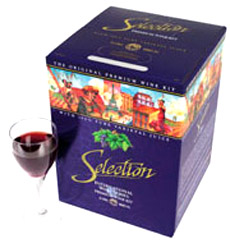 the first three months of this year than in the same period in 2006. Experts credit the rapid growth in general wine sales with fueling interest in homemade wine. Within three years, Americans are expected to consume nearly 3.8 billion bottles of wine annually, which would make the U.S. the largest wine-consuming country in the world, surpassing historical “winners” Italy and France.* You don’t even need a cellar or an extra room: The Minneapolis Star-Tribune reports of Vine Park, a thriving “brew on premises” business where customers come in to brew their own beer or wine, then come back to bottle it later. Wine accounted for more than half of the company’s 30% sales increase last year; in 2005, wine contributed to only 6% of the increase. In addition to the pride of becoming a “vintner,” the price is right: Wine ingredient kits, which contain everything needed to make wine, cost $30 to $160, depending on the quality of the juice concentrate. Organic concentrates are also available. One kit produces 30 bottles of wine. The initial investment of equipment to get started, including the cost of bottles, is about $100. That’s $6 a bottle for wine from the best juice, amortizing the cost of the equipment, for a wine equivalent to a $15 or greater retail purchase. Perhaps for Mother’s Day or Father’s Day, you can give a gift to get the celebrant started on Chateau Your Family. Photo of winemaking kit from HamiltonHopsandGrapes.com. the first three months of this year than in the same period in 2006. Experts credit the rapid growth in general wine sales with fueling interest in homemade wine. Within three years, Americans are expected to consume nearly 3.8 billion bottles of wine annually, which would make the U.S. the largest wine-consuming country in the world, surpassing historical “winners” Italy and France.* You don’t even need a cellar or an extra room: The Minneapolis Star-Tribune reports of Vine Park, a thriving “brew on premises” business where customers come in to brew their own beer or wine, then come back to bottle it later. Wine accounted for more than half of the company’s 30% sales increase last year; in 2005, wine contributed to only 6% of the increase. In addition to the pride of becoming a “vintner,” the price is right: Wine ingredient kits, which contain everything needed to make wine, cost $30 to $160, depending on the quality of the juice concentrate. Organic concentrates are also available. One kit produces 30 bottles of wine. The initial investment of equipment to get started, including the cost of bottles, is about $100. That’s $6 a bottle for wine from the best juice, amortizing the cost of the equipment, for a wine equivalent to a $15 or greater retail purchase. Perhaps for Mother’s Day or Father’s Day, you can give a gift to get the celebrant started on Chateau Your Family. Photo of winemaking kit from HamiltonHopsandGrapes.com.
*According to a recent study by Vinexpo, producers of a leading international wine and spirits show.
It’s Easier To Veg Out. There are between 1,000 and 1,200 vegetarian restaurants in the U.S., almost double the number seven years ago, according to the VegDining.com, an online guide to vegetarian restaurants. Part of the transformation is due to advances in cooking that allow chefs to prepare proteins like tofu with a taste and texture similar to meat. They can also work magic with tempeh, which consists of fermented soybeans with a more grainy texture than tofu, and seitan, a 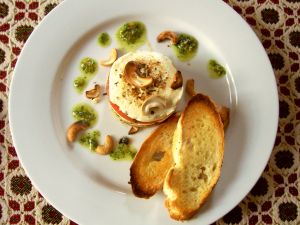 concentrated wheat gluten. Once a network of obscure “health food” cafés, the vegetarian and vegan experience in some cities has blossomed into fine cuisine with Zagat ratings and celebrity clienteles. Dennis Bayomi, president of VegDining.com, estimates there are more than a dozen fine dining vegan eateries nationwide (in addition to being meat-free, vegans eat no animal by-products, including dairy, eggs and honey). An expanding global pantry has contributed vegetarian dishes from other countries. The Associated Press reports that Chef Rich Landau and his wife Kate Jacoby opened Horizons in the Philadelphia suburbs 11 years ago, expecting to serve hummus to college kids, and was surprised when his restaurant filled with “suits and ties.” Now, Horizons is a chic downtown restaurant where diners wait an hour for a table on the weekends to enjoy pan-seared tofu with hearts of palm, poblano cream and agave baked beans, wasabi-glazed tempeh or a maitake and smoked eggplant empanada. New York City’s neighborhood cafe, Candle 79, on the Upper East Side, has celebrity regulars like Paul McCartney, Alicia Silverstone and Woody Harrelson: They’ve sold 3 million vegan meals in the last 20 years, like seitan piccata with lemon caper sauce and ancho-seared tempeh with roasted sweet potato purée and pomegranate reduction. Just because it’s meat-free doesn’t mean the food is cheaper: In fact, it’s costlier than traditional fare. It costs 40 percent more to serve organic products, which are generally preferred by vegetarians; and the labor to prepare vegetarian dishes is more intensive. concentrated wheat gluten. Once a network of obscure “health food” cafés, the vegetarian and vegan experience in some cities has blossomed into fine cuisine with Zagat ratings and celebrity clienteles. Dennis Bayomi, president of VegDining.com, estimates there are more than a dozen fine dining vegan eateries nationwide (in addition to being meat-free, vegans eat no animal by-products, including dairy, eggs and honey). An expanding global pantry has contributed vegetarian dishes from other countries. The Associated Press reports that Chef Rich Landau and his wife Kate Jacoby opened Horizons in the Philadelphia suburbs 11 years ago, expecting to serve hummus to college kids, and was surprised when his restaurant filled with “suits and ties.” Now, Horizons is a chic downtown restaurant where diners wait an hour for a table on the weekends to enjoy pan-seared tofu with hearts of palm, poblano cream and agave baked beans, wasabi-glazed tempeh or a maitake and smoked eggplant empanada. New York City’s neighborhood cafe, Candle 79, on the Upper East Side, has celebrity regulars like Paul McCartney, Alicia Silverstone and Woody Harrelson: They’ve sold 3 million vegan meals in the last 20 years, like seitan piccata with lemon caper sauce and ancho-seared tempeh with roasted sweet potato purée and pomegranate reduction. Just because it’s meat-free doesn’t mean the food is cheaper: In fact, it’s costlier than traditional fare. It costs 40 percent more to serve organic products, which are generally preferred by vegetarians; and the labor to prepare vegetarian dishes is more intensive.
Photo of pesto, feta and tomato stack with toasts by Willie Cloete.
More Americans Go “Locavore.” As the organic movement becomes more mainstream, early organic advocates are now moving from organic to “local” choices, buying from small, nearby farms that use sustainable (but not necessarily organic) growing practices. The term “locavore”† has been coined to describe a person who bases most of his or her diet on food grown regionally. (When restaurants talk about their “farm to table cuisine,” that’s the same thing.) Even institutions are demanding locally-grown foods: From Emory University in Atlanta to Google headquarters in Silicon Valley, chefs have been tasked with buying them. The appeal of local food is not just freshness: With ongoing food scares, while there’s no guarantee, the chances are that food grown on a small scale in a nearby area is much less likely to be contaminated. Environmentally-conscious locavores like that fuel is saved in transporting food shorter distances—as well as less air pollution from burning fossil fuel. Much of what is sold at farmers’ markets is considered sustainable rather than organic: Organic certification requires strict standards established by the U.S. Department of Agriculture. Some farmers have dropped (or never pursued) their certification while still using organic methods, relying on personal connections with customers who trust they are getting organic quality, and are happy to give up the detailed paperwork required by the USDA. Whether at farmers’ markets or through CSAs (community-supported agriculture, where customers pay in advance for a weekly delivery from a farmer, and 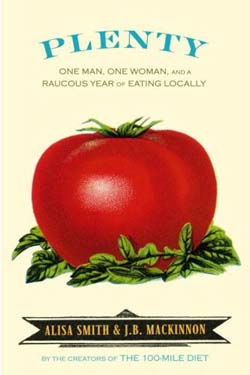 the advance cash ensures the farmer an income), even “everyday” consumers are paying more for locally grown produce, milk and eggs from small farmers. Best-selling novelist Barbara Kingsolver has joins the “green” trend of environmentally-conscious living with her new book, Animal, Vegetable, Miracle: A Year of Food Life, chronicling how she and her family grow a large garden in Appalachia and vow to buy only food raised in their own neighborhood. In Vancouver, a much colder clime, Alisa Smith and J.B. MacKinnon limited themselves to food grown within 100 miles of their home and recounted their experience in Plenty: One Man, One Woman and a Raucous Year of Eating Locally. Locavores eat “the old fashioned way”—seasonally, waiting for delicious summer tomatoes and substituting sundried and roasted red peppers during the winter months, and delicious citrus fruits in the winter instead of tasteless flown-in strawberries. For definitions of sustainable, organic and other words, see our Glossary of Organic & Natural Food Terms. the advance cash ensures the farmer an income), even “everyday” consumers are paying more for locally grown produce, milk and eggs from small farmers. Best-selling novelist Barbara Kingsolver has joins the “green” trend of environmentally-conscious living with her new book, Animal, Vegetable, Miracle: A Year of Food Life, chronicling how she and her family grow a large garden in Appalachia and vow to buy only food raised in their own neighborhood. In Vancouver, a much colder clime, Alisa Smith and J.B. MacKinnon limited themselves to food grown within 100 miles of their home and recounted their experience in Plenty: One Man, One Woman and a Raucous Year of Eating Locally. Locavores eat “the old fashioned way”—seasonally, waiting for delicious summer tomatoes and substituting sundried and roasted red peppers during the winter months, and delicious citrus fruits in the winter instead of tasteless flown-in strawberries. For definitions of sustainable, organic and other words, see our Glossary of Organic & Natural Food Terms.
†Vorare, the Latin root of carnivore, herbivore and omnivore, means “to eat ravenously.”
Pro[biotic] Choice. Probiotics are sweeping the dairy industry in a big way. Probiotics are living microorganisms that are added to dairy products and other foods (like nutrition bars and even chocolate) to aid consumer digestion and boost the 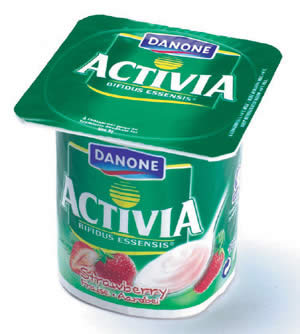 immune system. According to USProbiotics.org, a nonprofit research and education website funded by the California Dairy Research Foundation, probiotics aid digestion by balancing naturally occurring gut flora. They’ve been hot in Europe for 20 years, but only now getting into the American diet. For example, Dannon’s Activia, a yogurt with probiotics that improve overall digestion (and the most widely marketed probiotic brand), introduced in January 2006, has been sold in Europe since for more than 20 years. Dannon introduced its DanActive line of probiotic drinkable yogurts in Europe in 1984 and later expanded to Asia under the brand name Actimel; more than 6 million bottles are sold daily! Probiotics fits into a larger trend of functional foods and beverages—products pumped with everything from Vitamin D to Omega-3 fatty acids in an effort to boost nutrition and get customers to pay top dollar for enhanced foods. Do Americans like probiotics? Within one year of its launch in January 2006, Activia surpassed $100 million in retail grocery sales, something achieved by less than one tenth of one percent of all new products in their first year in the U.S., according to Dannon. American food giant Dean Foods Co., owner of the Horizon organic brand, recently brought its probiotic yogurt brand, Rachel’s Organic, to the U.S. from the U.K., where it has been a hit for years. In January, Lifeway Foods introduced a line of probiotic, organic kefir yogurt drinks aimed at children called ProBugs, and earlier this year Dannon added Lactobacillus GG, one of the more well researched probiotic cultures, to its Danimals line of drinkable yogurts aimed at kids. immune system. According to USProbiotics.org, a nonprofit research and education website funded by the California Dairy Research Foundation, probiotics aid digestion by balancing naturally occurring gut flora. They’ve been hot in Europe for 20 years, but only now getting into the American diet. For example, Dannon’s Activia, a yogurt with probiotics that improve overall digestion (and the most widely marketed probiotic brand), introduced in January 2006, has been sold in Europe since for more than 20 years. Dannon introduced its DanActive line of probiotic drinkable yogurts in Europe in 1984 and later expanded to Asia under the brand name Actimel; more than 6 million bottles are sold daily! Probiotics fits into a larger trend of functional foods and beverages—products pumped with everything from Vitamin D to Omega-3 fatty acids in an effort to boost nutrition and get customers to pay top dollar for enhanced foods. Do Americans like probiotics? Within one year of its launch in January 2006, Activia surpassed $100 million in retail grocery sales, something achieved by less than one tenth of one percent of all new products in their first year in the U.S., according to Dannon. American food giant Dean Foods Co., owner of the Horizon organic brand, recently brought its probiotic yogurt brand, Rachel’s Organic, to the U.S. from the U.K., where it has been a hit for years. In January, Lifeway Foods introduced a line of probiotic, organic kefir yogurt drinks aimed at children called ProBugs, and earlier this year Dannon added Lactobacillus GG, one of the more well researched probiotic cultures, to its Danimals line of drinkable yogurts aimed at kids.
Learn more about probiotics in our extensive article in this month’s magazine.

News Archives
| 3rd Quarter 2007 |
|
|
|
|
|
| 1st Quarter 2007 |
4th Quarter 2006 |
3rd Quarter 2006 |
|
|
|
| 2nd Quarter 2006 |
1st Quarter 2006 |
4th Quarter 2005 |
|
|
|
| 3rd Quarter 2005 |
2nd Quarter 2005 |
1st Quarter 2005 |
|
|
|
Send your product news to:
Info at TheNibble. com.
Substitute @ for <at> and use TheNibble.com with no space. We use this convention to avoid address-harvesting spam spiders.
Don’t Miss The News:
Subscribe To Our Gourmet News & Views News Feed
Lifestyle Direct Direct, Inc. All rights reserved. Images are the copyright of their respective owners.

|




 You can eat the beautiful spring flowers as well as enjoy them in your garden, with this delicious cheesecake. Available from MackenzieLtd.com.
You can eat the beautiful spring flowers as well as enjoy them in your garden, with this delicious cheesecake. Available from MackenzieLtd.com. 
 Nespresso doesn’t want to be in the coffee shop business, because this is as first-class an operation as one could wish for. If only we could wave a wand and have every other coffee shop we need to visit turn into a Nespresso shop. The many varieties of espresso (including cappuccino, latte and cold drinks) are perfetto, the furnishings are elegant, the staff is erudite, the prices are the same as at any other shop. But the purpose of the Nespresso Boutique Bar is to introduce Nespresso’s espresso machines. They are capsule machines: With just a touch of a button, perfect espresso is made in 10 seconds. There are nine premium espressos and three “lungo” blends (more American style for larger cups of coffee). In September, what we think is the world’s best cappuccino machine, the Lattissimo, will be on the market; so if you’re a cappuccino fan, put it on your list. It will be in the $650-$750 range, depending on finish. Learn more at Nespresso.com.
Nespresso doesn’t want to be in the coffee shop business, because this is as first-class an operation as one could wish for. If only we could wave a wand and have every other coffee shop we need to visit turn into a Nespresso shop. The many varieties of espresso (including cappuccino, latte and cold drinks) are perfetto, the furnishings are elegant, the staff is erudite, the prices are the same as at any other shop. But the purpose of the Nespresso Boutique Bar is to introduce Nespresso’s espresso machines. They are capsule machines: With just a touch of a button, perfect espresso is made in 10 seconds. There are nine premium espressos and three “lungo” blends (more American style for larger cups of coffee). In September, what we think is the world’s best cappuccino machine, the Lattissimo, will be on the market; so if you’re a cappuccino fan, put it on your list. It will be in the $650-$750 range, depending on finish. Learn more at Nespresso.com. 
 favorite of Marie Antoinette, and Marilyn Monroe is said to have awoken every morning to a glass of Piper (she may have preferred coffee, but Champagne made better fodder for magazines). This summer, the venerable Champagne house is making an effort to be cool while keeping its patrons cool. One approach is the Piper-Heidsieck Cool Box, a bottle of Piper Cuvée Brut that comes in its own handsome Champagne chilling container. Another is by promoting the Piscine (French for “swimming pool”) cocktail served with Champagne ice cubes instead of in a flute. After you pour it from the Cool Box, your glass of bubbly stays ice cold while you laze in the sun. Of course, you need to devote part of a bottle of Champagne to making the ice cubes, so it helps to have a
favorite of Marie Antoinette, and Marilyn Monroe is said to have awoken every morning to a glass of Piper (she may have preferred coffee, but Champagne made better fodder for magazines). This summer, the venerable Champagne house is making an effort to be cool while keeping its patrons cool. One approach is the Piper-Heidsieck Cool Box, a bottle of Piper Cuvée Brut that comes in its own handsome Champagne chilling container. Another is by promoting the Piscine (French for “swimming pool”) cocktail served with Champagne ice cubes instead of in a flute. After you pour it from the Cool Box, your glass of bubbly stays ice cold while you laze in the sun. Of course, you need to devote part of a bottle of Champagne to making the ice cubes, so it helps to have a  Organic chocolate pioneer Dagoba has introduced a 68% cacao chocolate bar—still semisweet (the bittersweet border is considered to be 70%), with omega-rich hemp seeds, heart-healthy pumpkin and sunflower seeds and to remind us that it’s a modern bar, a touch of Balinese sea salt. Don’t be convinced that this is health food though: There’s enough fat and sugar in any chocolate bar to make “health benefits” a delusion (the exception to the rule is that those who eat 99% or 100% cacao avoid the sugar—but that’s not most of us). For more information, visit DagobaChocolate.com.
Organic chocolate pioneer Dagoba has introduced a 68% cacao chocolate bar—still semisweet (the bittersweet border is considered to be 70%), with omega-rich hemp seeds, heart-healthy pumpkin and sunflower seeds and to remind us that it’s a modern bar, a touch of Balinese sea salt. Don’t be convinced that this is health food though: There’s enough fat and sugar in any chocolate bar to make “health benefits” a delusion (the exception to the rule is that those who eat 99% or 100% cacao avoid the sugar—but that’s not most of us). For more information, visit DagobaChocolate.com.  dishes. Nation’s Restaurant News reported on some popular new dishes at restaurants nationwide that you can make at home: a steak and Gorgonzola salad with arugula and spinach, tossed with vinaigrette and garnished with candied walnuts (from Maggiano’s Little Italy in Dallas). We love nutmeg as a seasoning for spinach, but Youssef Hammi, chef at Himmarshee Bar & Grille in Fort Lauderdale, recommends sage. To get more vegetables in your diet, serve grilled fish, chicken or other protein atop a bed of wilted baby spinach leaves; add some toasted pine nuts and a dab of garlic butter or other compound butter. Spinach is high in vitamins A, C, K and folate and is also a good source of iron and magnesium. It also features lutein, an antioxidant that protects against macular degeneration, or loss of eyesight. If you still feel anxiety about bringing spinach back, remember that it was regular spinach that caused the problems last year, not baby spinach.
dishes. Nation’s Restaurant News reported on some popular new dishes at restaurants nationwide that you can make at home: a steak and Gorgonzola salad with arugula and spinach, tossed with vinaigrette and garnished with candied walnuts (from Maggiano’s Little Italy in Dallas). We love nutmeg as a seasoning for spinach, but Youssef Hammi, chef at Himmarshee Bar & Grille in Fort Lauderdale, recommends sage. To get more vegetables in your diet, serve grilled fish, chicken or other protein atop a bed of wilted baby spinach leaves; add some toasted pine nuts and a dab of garlic butter or other compound butter. Spinach is high in vitamins A, C, K and folate and is also a good source of iron and magnesium. It also features lutein, an antioxidant that protects against macular degeneration, or loss of eyesight. If you still feel anxiety about bringing spinach back, remember that it was regular spinach that caused the problems last year, not baby spinach.  the way those coffees taste. Now, you’re going to learn which coffee pairs best with which food. The foodservice division of Sara Lee, the country’s largest dining program coffee producer whose offerings include Douwe Egberts (the coffee in
the way those coffees taste. Now, you’re going to learn which coffee pairs best with which food. The foodservice division of Sara Lee, the country’s largest dining program coffee producer whose offerings include Douwe Egberts (the coffee in  The nut underneath is a creamy white color, like the macadamia. Raw and unsalted, their taste is subtle compared to the common goobers we’re used to, somewhat green and healthy-tasting with interesting nuances and a softer texture than most nuts. Most people might not guess they’re peanuts. Like any other peanut, they can be eaten straight out of the bag or added to recipes, and score high in nutrition: 26% protein, heart-healthy oleic acid, all eight essential amino acids and arachidonic acid, a fatty acid typically only found in meat products. For more information about Organic Wild Amazonian Jungle Peanuts, visit Sunfood.com. Sunfood Nutrition founder David Wolfe is also the President of The Fruit Tree Planting Foundation (ftpf.org), a nonprofit organization dedicated to planting fruitful trees and edible plants to benefit the environment and its inhabitants. FTPF’s mission is to plant 18 billion fruit trees across the world and encourage their growth under organic standards.
The nut underneath is a creamy white color, like the macadamia. Raw and unsalted, their taste is subtle compared to the common goobers we’re used to, somewhat green and healthy-tasting with interesting nuances and a softer texture than most nuts. Most people might not guess they’re peanuts. Like any other peanut, they can be eaten straight out of the bag or added to recipes, and score high in nutrition: 26% protein, heart-healthy oleic acid, all eight essential amino acids and arachidonic acid, a fatty acid typically only found in meat products. For more information about Organic Wild Amazonian Jungle Peanuts, visit Sunfood.com. Sunfood Nutrition founder David Wolfe is also the President of The Fruit Tree Planting Foundation (ftpf.org), a nonprofit organization dedicated to planting fruitful trees and edible plants to benefit the environment and its inhabitants. FTPF’s mission is to plant 18 billion fruit trees across the world and encourage their growth under organic standards. foray into organics, with an Organic Peanut Butter Bon. A creamy peanut butter center is covered in deep milk chocolate and topped with
foray into organics, with an Organic Peanut Butter Bon. A creamy peanut butter center is covered in deep milk chocolate and topped with 
 News, a growing body of research suggests that heavy coffee consumption may lower the risk of Type 2 diabetes and other serious diseases. Rob M. van Dam, PhD, a Harvard researcher, concludes from an analysis he did in 2005 of eight major studies that adults who consume six to seven cups of coffee per day lower their risk of diabetes by one-third over those who drink two cups per day. He stated that another study done last year showed that two or three cups per day lowered women’s diabetes risk by 13%, four or more cups per day cut the risk by more than 40%. At least seven other studies suggest similar benefits. According to Lenore Arab, PhD, a nutritional epidemiologist at UCLA, other studies suggest that coffee could help lower the risk of liver cancer, Parkinson’s disease, and possibly colon cancer. This is good news to the tens of millions of American coffee drinkers.
News, a growing body of research suggests that heavy coffee consumption may lower the risk of Type 2 diabetes and other serious diseases. Rob M. van Dam, PhD, a Harvard researcher, concludes from an analysis he did in 2005 of eight major studies that adults who consume six to seven cups of coffee per day lower their risk of diabetes by one-third over those who drink two cups per day. He stated that another study done last year showed that two or three cups per day lowered women’s diabetes risk by 13%, four or more cups per day cut the risk by more than 40%. At least seven other studies suggest similar benefits. According to Lenore Arab, PhD, a nutritional epidemiologist at UCLA, other studies suggest that coffee could help lower the risk of liver cancer, Parkinson’s disease, and possibly colon cancer. This is good news to the tens of millions of American coffee drinkers.  eliminating the rights of Americans to eat foie gras. They achieved a huge victory by getting Arnold Schwartzenegger to support a law that will ban foie gras starting in 2012 (we’re betting the Governator personally doesn’t like foie gras) and the Chicago Assembly to outlaw the sale of foie gras last year. The same activists are attempting to instigate action in New York and elsewhere; while we don’t anticipate foie gras speakeasies, Chicago restaurants have shown creative ways of getting around the legislation. Opponents of foie gras say the procedure of using feeding tubes is painful and sickens the birds, but no veterinary organizations have supported this stance. Supporters say the birds’ gullets are naturally expandable (think of pelicans swallowing whole fish), and that they naturally gorge before migrating, so that neither of the alleged “cruel and unusual punishment” accusations are valid. THE NIBBLE fears the danger of allowing fringe groups to legislate what can be eaten, worn or otherwise consumed—has always been surprised that, given the tiny size of the foie gras industry, animal activists are so vehement about spending their time and energy on such a small group of animals that is farmed in just a handful of countries. We opine that their concerns for animal welfare could make a truly significant impact by improving the condition of the many millions of lobsters and crabs, who are plunged live to their deaths in boiling water in many nations around the world. Between finding a less painful way to kill many millions of crustaceans and the feeding method of thousands of geese, which problem should be solved first?
eliminating the rights of Americans to eat foie gras. They achieved a huge victory by getting Arnold Schwartzenegger to support a law that will ban foie gras starting in 2012 (we’re betting the Governator personally doesn’t like foie gras) and the Chicago Assembly to outlaw the sale of foie gras last year. The same activists are attempting to instigate action in New York and elsewhere; while we don’t anticipate foie gras speakeasies, Chicago restaurants have shown creative ways of getting around the legislation. Opponents of foie gras say the procedure of using feeding tubes is painful and sickens the birds, but no veterinary organizations have supported this stance. Supporters say the birds’ gullets are naturally expandable (think of pelicans swallowing whole fish), and that they naturally gorge before migrating, so that neither of the alleged “cruel and unusual punishment” accusations are valid. THE NIBBLE fears the danger of allowing fringe groups to legislate what can be eaten, worn or otherwise consumed—has always been surprised that, given the tiny size of the foie gras industry, animal activists are so vehement about spending their time and energy on such a small group of animals that is farmed in just a handful of countries. We opine that their concerns for animal welfare could make a truly significant impact by improving the condition of the many millions of lobsters and crabs, who are plunged live to their deaths in boiling water in many nations around the world. Between finding a less painful way to kill many millions of crustaceans and the feeding method of thousands of geese, which problem should be solved first? and Moscow, has announced that the 10 year anniversary of the show will be held at the New York show, from November 9th to 11th. The show is held at the Metropolitan Pavilion and Altman Building in New York City. This year’s show will feature some of the most famous pastry chefs and chocolate makers in the U.S., beginning with the chocolate fashion show—leading fashion designers paired with pastry chefs creating unconventional clothing in chocolate—on the evening of Thursday, November 8. For the 10th anniversary celebration, the week leading up to the main chocolate fashion show will be filled with an extensive program of mini events. Mark your calendars! Read more about
and Moscow, has announced that the 10 year anniversary of the show will be held at the New York show, from November 9th to 11th. The show is held at the Metropolitan Pavilion and Altman Building in New York City. This year’s show will feature some of the most famous pastry chefs and chocolate makers in the U.S., beginning with the chocolate fashion show—leading fashion designers paired with pastry chefs creating unconventional clothing in chocolate—on the evening of Thursday, November 8. For the 10th anniversary celebration, the week leading up to the main chocolate fashion show will be filled with an extensive program of mini events. Mark your calendars! Read more about  antioxidants than the leading dark chocolate.” That may be, but don’t expect antioxidant health benefits from eating it given the 19 grams of sugar, 180 calories and 100 fat calories in a 1.3-ounce bar. It’s a bar of extremely sweet milk chocolate—not unlike a regular Hershey bar, the sugar overwhelms the chocolate flavor. While the company promotes “smooth, creamy milk chocolate taste,” we find that it has the texture of inexpensive chocolate—fibrous, not melt-in-your-mouth creamy in the least. Our recommendation: Forget the antioxidant hype, there aren’t enough antioxidants in this bar to do anything but make you feel psychologically better. If you want to eat a wonderful milk chocolate bar, try the company’s fine
antioxidants than the leading dark chocolate.” That may be, but don’t expect antioxidant health benefits from eating it given the 19 grams of sugar, 180 calories and 100 fat calories in a 1.3-ounce bar. It’s a bar of extremely sweet milk chocolate—not unlike a regular Hershey bar, the sugar overwhelms the chocolate flavor. While the company promotes “smooth, creamy milk chocolate taste,” we find that it has the texture of inexpensive chocolate—fibrous, not melt-in-your-mouth creamy in the least. Our recommendation: Forget the antioxidant hype, there aren’t enough antioxidants in this bar to do anything but make you feel psychologically better. If you want to eat a wonderful milk chocolate bar, try the company’s fine  combinations to hit town over the last several years. We admit a fondness for all salted bars, including
combinations to hit town over the last several years. We admit a fondness for all salted bars, including  certified-organic, authentically strained Greek-style yogurt, which is thicker than European-style yogurt, called Oikos Organic (oikos means house or household in Greek). Using authentic Greek recipes, the yogurt is made in the U.S.The brand will be called Greek-style yogurts are the fastest growing segment in natural foods channels. The Oikos line has 0% fat and is available in both plain and vanilla, the latter a new flavor for lovers of Greek yogurt. The yogurt includes five live and active cultures, including L. acidophilus, Bifidus and L. Casei. It’s diet-friendly, with 120 calories or less, 0g fat and 16g of protein per 6-ounce serving. The suggested retail price is $1.89 per 6-ounce cup and $4.49 per 16-ounce tub. Learn more at OikosYogurt.com.
certified-organic, authentically strained Greek-style yogurt, which is thicker than European-style yogurt, called Oikos Organic (oikos means house or household in Greek). Using authentic Greek recipes, the yogurt is made in the U.S.The brand will be called Greek-style yogurts are the fastest growing segment in natural foods channels. The Oikos line has 0% fat and is available in both plain and vanilla, the latter a new flavor for lovers of Greek yogurt. The yogurt includes five live and active cultures, including L. acidophilus, Bifidus and L. Casei. It’s diet-friendly, with 120 calories or less, 0g fat and 16g of protein per 6-ounce serving. The suggested retail price is $1.89 per 6-ounce cup and $4.49 per 16-ounce tub. Learn more at OikosYogurt.com. 

 2005 production. Wisconsin was the leading state producer, with 25.9% of the production; California took second. Not surprisingly, due to the popularity of pizza and other Italian foods, Italian varieties led production, with 3.99 billion pounds accounting for 41.8% of total cheese produced in 2006. Mozzarella accounted for 78.8% of the Italian production, followed by Provolone with 8% and Ricotta with 6.1%. California was the leading state in Italian cheese production, manufacturing 29.7%. Following America’s love of cheeseburgers, American-type cheese was the second largest type produced, at 3.91 billion pounds; Wisconsin led with 21% of production. We consumed
2005 production. Wisconsin was the leading state producer, with 25.9% of the production; California took second. Not surprisingly, due to the popularity of pizza and other Italian foods, Italian varieties led production, with 3.99 billion pounds accounting for 41.8% of total cheese produced in 2006. Mozzarella accounted for 78.8% of the Italian production, followed by Provolone with 8% and Ricotta with 6.1%. California was the leading state in Italian cheese production, manufacturing 29.7%. Following America’s love of cheeseburgers, American-type cheese was the second largest type produced, at 3.91 billion pounds; Wisconsin led with 21% of production. We consumed  Drink With The Sopranos.
Drink With The Sopranos.
 A saké with at least 30% of the grain removed is referred to as junmai or junmaishu; at least 40% is ginjo or ginjoshu. Junmais and ginjos can be paired with bigger flavor foods, like toro, grilled chicken and tempura. Rice polished 50% or more creates the more delicate daiginjo or daiginjoshu sakés, which pairs with more gently flavored foods, such as poached whitefish or raw scallop. A fourth category, honjozo or honjozukuri, refers to a saké to which a small amount of pure alcohol has been added during the fermentation period. And a fifth type, nigori or nigorizaké is loosely filtered saké that is cloudy, almost milky white. Pair them with spicy or heavily fried foods and lighter meats.
A saké with at least 30% of the grain removed is referred to as junmai or junmaishu; at least 40% is ginjo or ginjoshu. Junmais and ginjos can be paired with bigger flavor foods, like toro, grilled chicken and tempura. Rice polished 50% or more creates the more delicate daiginjo or daiginjoshu sakés, which pairs with more gently flavored foods, such as poached whitefish or raw scallop. A fourth category, honjozo or honjozukuri, refers to a saké to which a small amount of pure alcohol has been added during the fermentation period. And a fifth type, nigori or nigorizaké is loosely filtered saké that is cloudy, almost milky white. Pair them with spicy or heavily fried foods and lighter meats. the first three months of this year than in the same period in 2006. Experts credit the rapid growth in general wine sales with fueling interest in homemade wine. Within three years, Americans are expected to consume nearly 3.8 billion bottles of wine annually, which would make the U.S. the largest wine-consuming country in the world, surpassing historical “winners” Italy and France.* You don’t even need a cellar or an extra room: The Minneapolis Star-Tribune reports of Vine Park, a thriving “brew on premises” business where customers come in to brew their own beer or wine, then come back to bottle it later. Wine accounted for more than half of the company’s 30% sales increase last year; in 2005, wine contributed to only 6% of the increase. In addition to the pride of becoming a “vintner,” the price is right: Wine ingredient kits, which contain everything needed to make wine, cost $30 to $160, depending on the quality of the juice concentrate. Organic concentrates are also available. One kit produces 30 bottles of wine. The initial investment of equipment to get started, including the cost of bottles, is about $100. That’s $6 a bottle for wine from the best juice, amortizing the cost of the equipment, for a wine equivalent to a $15 or greater retail purchase. Perhaps for Mother’s Day or Father’s Day, you can give a gift to get the celebrant started on Chateau Your Family.
the first three months of this year than in the same period in 2006. Experts credit the rapid growth in general wine sales with fueling interest in homemade wine. Within three years, Americans are expected to consume nearly 3.8 billion bottles of wine annually, which would make the U.S. the largest wine-consuming country in the world, surpassing historical “winners” Italy and France.* You don’t even need a cellar or an extra room: The Minneapolis Star-Tribune reports of Vine Park, a thriving “brew on premises” business where customers come in to brew their own beer or wine, then come back to bottle it later. Wine accounted for more than half of the company’s 30% sales increase last year; in 2005, wine contributed to only 6% of the increase. In addition to the pride of becoming a “vintner,” the price is right: Wine ingredient kits, which contain everything needed to make wine, cost $30 to $160, depending on the quality of the juice concentrate. Organic concentrates are also available. One kit produces 30 bottles of wine. The initial investment of equipment to get started, including the cost of bottles, is about $100. That’s $6 a bottle for wine from the best juice, amortizing the cost of the equipment, for a wine equivalent to a $15 or greater retail purchase. Perhaps for Mother’s Day or Father’s Day, you can give a gift to get the celebrant started on Chateau Your Family.  concentrated wheat gluten. Once a network of obscure “health food” cafés, the vegetarian and vegan experience in some cities has blossomed into fine cuisine with Zagat ratings and celebrity clienteles. Dennis Bayomi, president of VegDining.com, estimates there are more than a dozen fine dining vegan eateries nationwide (in addition to being meat-free, vegans eat no animal by-products, including dairy, eggs and honey). An expanding global pantry has contributed vegetarian dishes from other countries. The Associated Press reports that Chef Rich Landau and his wife Kate Jacoby opened Horizons in the Philadelphia suburbs 11 years ago, expecting to serve hummus to college kids, and was surprised when his restaurant filled with “suits and ties.” Now, Horizons is a chic downtown restaurant where diners wait an hour for a table on the weekends to enjoy pan-seared tofu with hearts of palm, poblano cream and agave baked beans, wasabi-glazed tempeh or a maitake and smoked eggplant empanada. New York City’s neighborhood cafe, Candle 79, on the Upper East Side, has celebrity regulars like Paul McCartney, Alicia Silverstone and Woody Harrelson: They’ve sold 3 million vegan meals in the last 20 years, like seitan piccata with lemon caper sauce and ancho-seared tempeh with roasted sweet potato purée and pomegranate reduction. Just because it’s meat-free doesn’t mean the food is cheaper: In fact, it’s costlier than traditional fare. It costs 40 percent more to serve organic products, which are generally preferred by vegetarians; and the labor to prepare vegetarian dishes is more intensive.
concentrated wheat gluten. Once a network of obscure “health food” cafés, the vegetarian and vegan experience in some cities has blossomed into fine cuisine with Zagat ratings and celebrity clienteles. Dennis Bayomi, president of VegDining.com, estimates there are more than a dozen fine dining vegan eateries nationwide (in addition to being meat-free, vegans eat no animal by-products, including dairy, eggs and honey). An expanding global pantry has contributed vegetarian dishes from other countries. The Associated Press reports that Chef Rich Landau and his wife Kate Jacoby opened Horizons in the Philadelphia suburbs 11 years ago, expecting to serve hummus to college kids, and was surprised when his restaurant filled with “suits and ties.” Now, Horizons is a chic downtown restaurant where diners wait an hour for a table on the weekends to enjoy pan-seared tofu with hearts of palm, poblano cream and agave baked beans, wasabi-glazed tempeh or a maitake and smoked eggplant empanada. New York City’s neighborhood cafe, Candle 79, on the Upper East Side, has celebrity regulars like Paul McCartney, Alicia Silverstone and Woody Harrelson: They’ve sold 3 million vegan meals in the last 20 years, like seitan piccata with lemon caper sauce and ancho-seared tempeh with roasted sweet potato purée and pomegranate reduction. Just because it’s meat-free doesn’t mean the food is cheaper: In fact, it’s costlier than traditional fare. It costs 40 percent more to serve organic products, which are generally preferred by vegetarians; and the labor to prepare vegetarian dishes is more intensive.
 immune system. According to USProbiotics.org, a nonprofit research and education website funded by the California Dairy Research Foundation, probiotics aid digestion by balancing naturally occurring gut flora. They’ve been hot in Europe for 20 years, but only now getting into the American diet. For example, Dannon’s Activia, a yogurt with probiotics that improve overall digestion (and the most widely marketed probiotic brand), introduced in January 2006, has been sold in Europe since for more than 20 years. Dannon introduced its DanActive line of probiotic drinkable yogurts in Europe in 1984 and later expanded to Asia under the brand name Actimel; more than 6 million bottles are sold daily! Probiotics fits into a larger trend of
immune system. According to USProbiotics.org, a nonprofit research and education website funded by the California Dairy Research Foundation, probiotics aid digestion by balancing naturally occurring gut flora. They’ve been hot in Europe for 20 years, but only now getting into the American diet. For example, Dannon’s Activia, a yogurt with probiotics that improve overall digestion (and the most widely marketed probiotic brand), introduced in January 2006, has been sold in Europe since for more than 20 years. Dannon introduced its DanActive line of probiotic drinkable yogurts in Europe in 1984 and later expanded to Asia under the brand name Actimel; more than 6 million bottles are sold daily! Probiotics fits into a larger trend of 